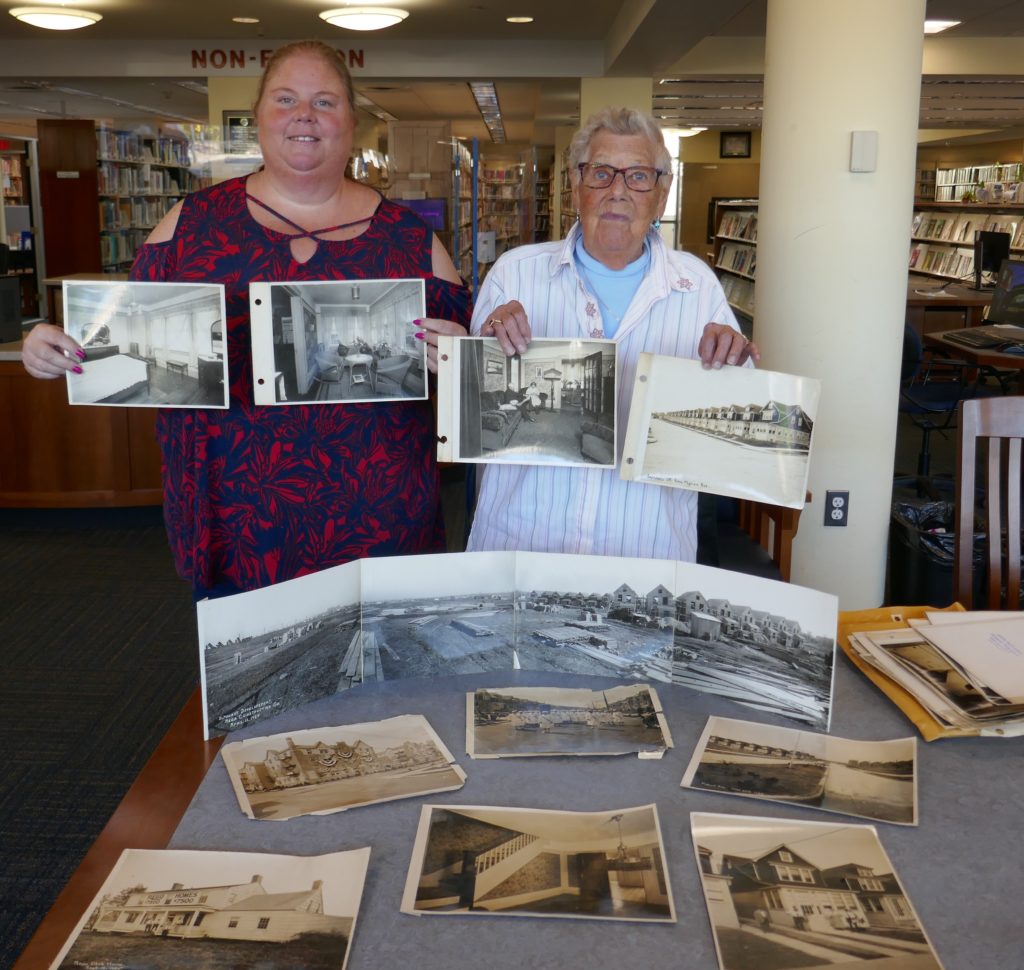Marion Legler recalls Rego Park’s early days
By Michael Perlman
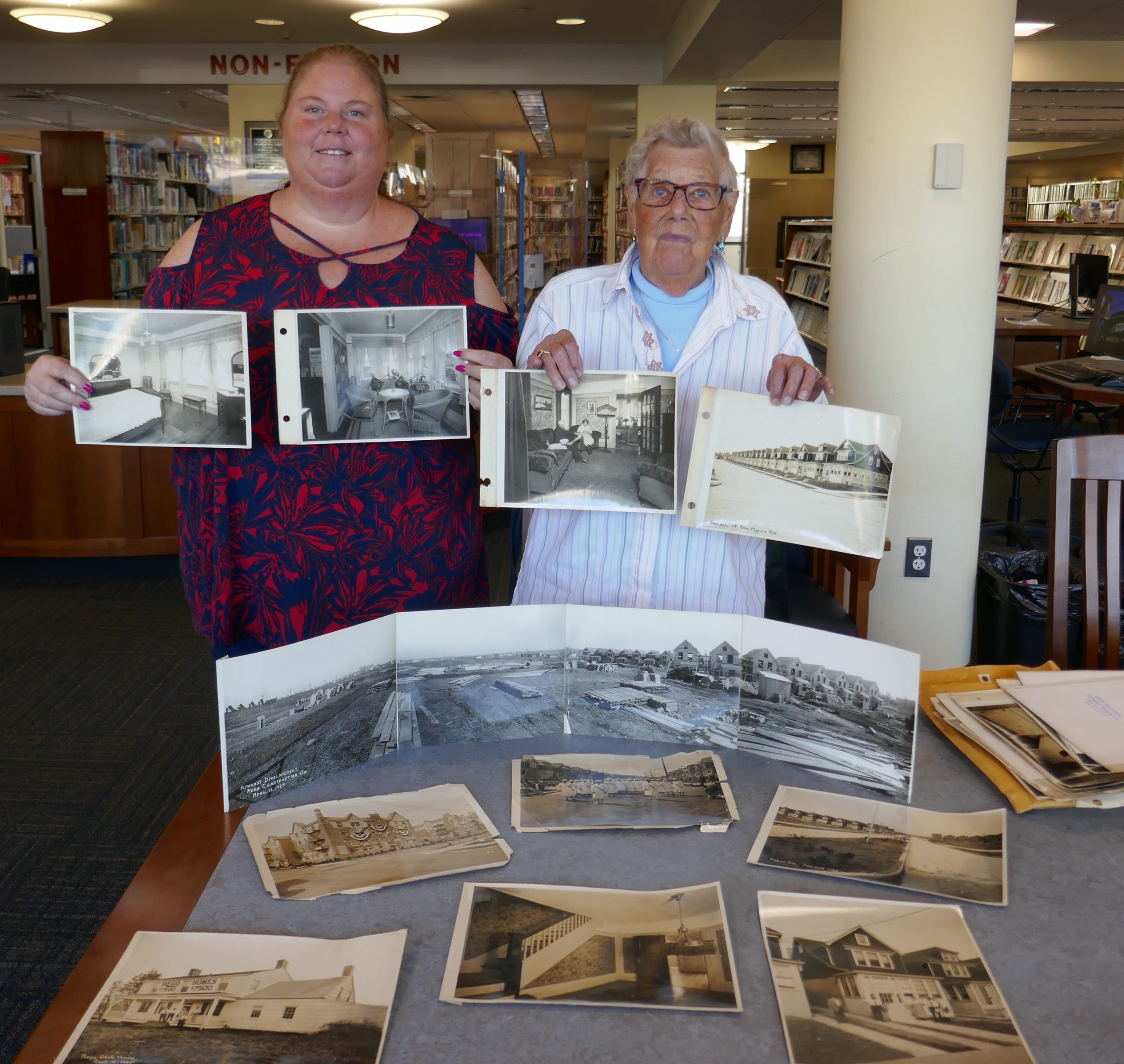
Marion Legler on right with her daughter Karen with a sample of an uncirculated 1920s Rego Park collection, Photo by Michael Perlman.
In just a few months, residents can say “Happy 100th Birthday, Rego Park!”
Last Friday, this columnist had a follow-up of a 2016 Rego Park tour and interview with Marion Thone Legler (born 1932), who reflected upon her early life in Rego Park and why it is a “REal GOod” community.
She is the granddaughter of Joseph F. Thone (1870 – 1955), a builder and founding member of the Real Good Construction Company, and is among the last links to the neighborhood’s origins.
Now a resident of New Hyde Park, the meeting at her local library entailed digitizing over 70 uncirculated Rego Park photos commissioned by the firm’s founders.
“I am very honored that my father passed my grandfather’s precious photos on to me,” said Legler. “They have many memories of wonderful years of the early history of Rego Park. A museum containing information regarding Rego Park and Forest Hills would be invaluable to so many families.”
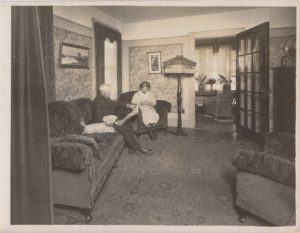
Marion Legler’s grandparents Joseph F Thone & Dorothea Thone doing chores in an elegant home, where only their dog poses.
Back in 1923, Rego Construction Company acquired farmland in Forest Hills West and named “Rego Park” after their advertising slogan, “REal GOod Homes.”
The typical story encompasses founders who immigrated from Germany; president Henry L. Schloh and secretary and treasurer Charles I. Hausmann, but Thone’s influence is a largely untold piece of the puzzle.
Legler’s rare photo collection documents a transition from farmland to a residential community in its first decade, the faces behind Rego Park and its earliest residents, the paving of roads, a trolley line along Queens Boulevard, the first shops, the Rego Park Community Club, P.S. 139, the ribbon-cutting of the 63rd Drive railroad station and a unique look inside an elegantly appointed house.
Many panoramic photos document the development of 525 eight-room, single-family “Rego Homes.” They included railroad-style Colonial frame houses with enclosed porches between 63rd Drive and Eliot Avenue along Saunders, Booth, Wetherole and Austin Streets, which sold for an approximate $7,500.
The collection follows with the development of the firm’s earliest and largely intact apartment houses along Saunders Street, which 70 families each called home: the Tudor-style Remo Hall (1927), the Spanish Mission-style Jupiter Court (1927) and Marion Court (1929), designed by Constantinople native Benjamin Braunstein.
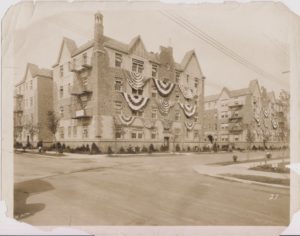
Remo Hall, 61-40 Saunders St adorned with banners.
Legler believes that she was named after the latter building situated on Marion Avenue (now 63rd Avenue), stemming from her grandfather’s interest in the name.
Legler discussed the importance of preservation. “I believe in those early days, much thought went into preserving history. You can see that in the care that was taken when choosing architectural design. I am sure it was thought that these buildings would be in use for many years,” she said.
“Try your best to keep it preserved for future generations. Many good people gave much time and thought into what they prayed would be a Real Good place for families to live for generations to come,” she continued. “Only those who are here now can be a part of that prayer. It is in your hands. Don’t let those good people down.”
She began writing a memoir last December, which is slated for publication in January 2023.
“All chapters are about my life and my friends and family. I am writing it for my four daughters and their children,” Legler explained. “It will contain pictures and life stories. I want them to have it in print for future references.”
Legler has a rich family timeline in Rego Park.
“It began with my grandfather and grandmother, Joseph F. Thone and Dorothea Thone. Their home was at 63-35 Bourton Street. Then my parents, William (America native) and Anne Thone (Norway native), my sister Dorothy, my brother Donald and myself. We lived at 61-30 Booth Street. Also, my uncle Joseph H. Thone, his wife Peggy and their children Russell and Carol lived at 62-87 Booth Street. My uncle Walter Thone also lived at 63-35 Bourton Street,” she said.
Legler is grateful for fond memories with her grandparents: “I spent many days at their home. It was so beautiful,” she continued. “My grandmother always made me feel loved. She had two cats and a parrot that spoke English and German. I actually lived with them for nine months when my grandmother was very sick and my mother took care of her. I loved her dearly. After she died, we moved back into our home on Booth Street.”
Original Rego Park houses were known as railroad room homes, straight through from the front porch to the living room, dining room and kitchen.
She said, “The kitchen was quite large. Off the kitchen was the pantry with the ice box, pantry closet and back door. The ice man would deliver ice and put it in the top compartment. Thank goodness that kept everything cold. Dugan’s and Krug’s were the bread people. In the beginning, they came on a horse and buggy. Upstairs was three bedrooms and a bathroom. Another essential was a coal chute in the basement, since there was no gas heat.”
She continued, “We were lucky, as my grandfather built a staircase to the attic where there was usually a closet. My sister and brother and I slept up there during the 1939 World’s Fair, so my parents could take in tourists for extra money. Things were tough in those days.”
Legler takes pride in solid family values to this day.
“Everybody had to be at the table. If you were late for dinner, you were in big trouble. Before we would leave the table, we would say, ‘takk for maten’ (thank you for the food).”
Sunday dinner was after church at 1 p.m. and consisted of mostly roast beef and sometimes turkey.
She said, “The vegetables… you ate them. Most were creamed and were German or Norwegian-style. Mom always made dessert…custard bread pudding, homemade pie, pineapple rice pudding from Norway and Brown Betty.”
Rego Park’s heyday featured diverse clubs: “Rego Park Community Club/Rego Park Clubhouse was on Jupiter Avenue (62nd Road) and Wetherole Street, where I had my wedding reception,” said Legler.
In 1928, her uncle Joseph H. Thone became president of the newly founded Rego Park Tennis Club, which operated on Saunders Street and 62nd Road.
Around 1929, he became secretary of the new Men’s Club of Lutheran Church of Our Saviour.
Legler recalls traveling mostly by bus or trolley, and then came the railroad and eventually the subway in 1936.
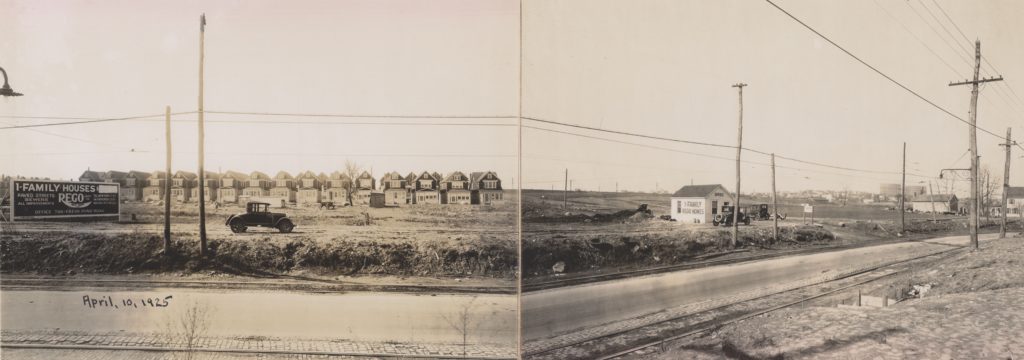
Queens Blvd trolley line with 2 cars, Rego Construction Co ad, Real Good Homes, April 10, 1925.
“I don’t know what my mom paid when we rode the trolley, but when I was old enough to ride the bus and subway, it was 5 cents,” she said.
Being raised in Rego Park was idyllic, according to Legler. A community fixture was “Buddy, the Bungalow Bar man.”
She reminisced, “I spent many days outdoors playing with neighborhood friends. We had great times playing handball, stickball, diamond ball, running basis, tag, football and stoop ball. At night, always hide and seek. Our parents would sit on the stoop and watch. We used to sleigh ride down 63rd Avenue and never had to worry about cars because there were very few. On Queens Boulevard, there were outdoor barbecue places, and we would be entertained for free.”
Off the north side of Queens Boulevard were swamps, Lost Battalion Hall and Howard Johnson’s.
The Art Deco Trylon Theater and Drake Theater were quite the attractions.
She said, “We always saw two movies, newsreels, cartoons and had a matron checking on us.” She saw mostly war films, but remembers many “Lassie” movies. She found “The Purple Heart” (1944) to be very moving.
She recalled her favorite shops: “On 63rd Drive, I loved Woolworth and across was McCrory’s. On Queens Boulevard between Eliot Avenue and 62nd, my dad owned a hardware store, which operated until ca.1939. I loved going there, since there were always fun things to see. He gave me my first roller skates; Kingston skates that came in a can.”
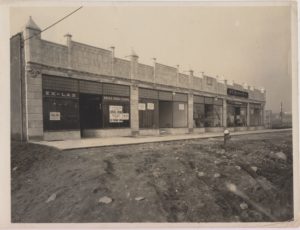
& plate glass, Queens Blvd near Eliot Ave.
Employment was sometimes a challenge, such as when her father gave up his hardware store during the Great Depression.
Legler is a graduate of P.S. 139, erected in 1929. She recalled, “We went from kindergarten through 8th grade. They taught arithmetic, the sciences, English, grammar and penmanship. In the upper grades, the boys took shop and the girls took home ed, which was learning how to be a housewife and a mother. Children went home for lunch.”
Victory gardening was prevalent during WWII and P.S. 139 participated.
“We grew carrots, lettuce, cucumbers, and celery,” Legler recalled. “We would bring money and buy what was called stamps, which was like a savings account. You learned how to cook in school, how to grow food outside, and how to save your money at the same time.”
Legler operated a key punch machine for General Motors. She said, “In 1950, my salary was $33 a week, and that was before they took everything out. We had food stamps, but they were good years, where families worked together.”
That same year, she graduated from Forest Hills High School and remained in Rego Park until her marriage in 1956 at Lutheran Church of Our Saviour.
Fast-forwarding to 2022, she said, “I am retired and spend as much time as I can with my children and grandchildren. Time is precious. Camping has always been a large part of our family’s time. I have done it with my girls since they were little, so today we have a trailer in the Poconos. This is my haven.”
Legler turned 90 on July 16 and her family threw her a party at her granddaughter Courtney’s home.
She said, “They did not surprise me this time about the party, but surprised me with who was invited. There were many good old friends and family members. Also, they hired a Mister Softee ice cream truck, my favorite.”
Her neighbor, who lived next door on Booth Street, turned 90 in August 2021.
She said,” I attended her celebration and she was at mine this year. I don’t know what they plan for my 100th, so I’ll try to stick around.”
Looking back, she said, “I am so proud to know that my grandfather played an important part in the development of Rego Park. It’s a ‘Real Good’ place to live that has lived up to its name.”


